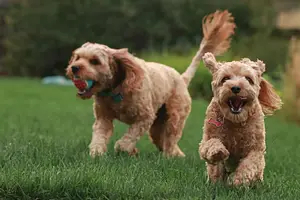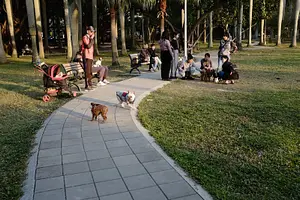This post is also available in:
Français (French)
Español (Spanish)
How to introduce dogs to each other can be a tricky task, but it doesn’t have to be.
You can help your dogs get along from the beginning with the right approach. This article will provide some tips and tricks for introducing your new furry friend to your other dogs, beginning with the first meeting.
If you already own a furry friend and are planning to adopt a dog, we encourage you to adopt one from a shelter; this will help an abandoned dog get a new and lovely home. You can either adopt from a local shelter, but if you feel like supporting the problem of homeless dogs in Mexico, you can adopt a dog from our shelter in Ajijic! Just choose your best friend, fill out our forms, and we will help you get your new furry friend to your closest airport!
Also, if you are not sure yet if your doggie will get along well with a new dog at home, you can first try fostering, and if you happen to live in the Lakeside Chapala area, you can foster one of our dogs before they arrive to their forever home!
Dogs meeting other dogs for the first time can set the tone for their relationship. Therefore, it is vital to handle this meeting with care. The following steps will help ensure that the first meeting goes smoothly:
Introduce in neutral territory. It’s best to let dogs become familiar with each other in a neutral environment, such as outdoors. Each dog should be walked separately on a leash, and each walker should have a bag of high-value treats or food broken into small pieces. At first, walk the dogs at a distance where they can see each other but are not too provoked by each other’s presence. If the dogs are not showing any negative behaviors, reward them with treats just for seeing each other. Repeat often.
Pay attention to each dog’s body language. Observe for body postures that indicate a defensive or wary response, including hair standing up on the dog’s back, teeth-baring, growling, a stiff-legged gait, or a prolonged stare. If you see such postures, either when the dogs are at a distance or near each other, immediately and calmly interrupt the interaction by attracting the dog’s attention to something else. If the dogs seem relaxed and comfortable, you can shorten the distance between them. Again, offer treats to the dogs whenever they calmly look at each other.
Let the dogs determine the pace of the introduction. Do not force the dogs to interact. The dogs may want to play with each other by the middle of the walk. It’s also possible that it will take more time before the dogs are comfortable enough to walk side by side. The most important thing is to take this introduction slowly. The more patient you are, the better your chance of success.
Monitor closely in the home. When introducing the dogs into the house, use a sturdy, tall baby gate to separate them. Observe how they interact through the gate. Reinforce positive behavior by providing high-value treats to the dogs for positive interactions. And nag them when they act aggressively, with compassion, constantly.
Ensure that no toys, food, or treats are left around the home that the dogs could potentially fight over. Also, be aware of situations that could lead to conflict—for example, when the dogs get overly excited because they can quickly start fighting from one moment to another.
Closely monitor the dogs when they are together, rewarding them with treats; you should only leave them without supervision until you are 100% confident they are comfortable and safe to avoid tragedy.
Seek professional help if necessary. If you want to make the transition smoother or are having trouble even with these considerations because the introductions aren’t going well, contact a professional trainer or animal behaviorist.
Conclusion
You can find challenges on how to introduce a new dog to each other, but with the right approach and patience, you can help them get along from the start. Don’t forget to always stay on the side of caution, dogs can injure between each other, so if they show any sign of aggresion, or you are not sure about the meaning of thier body language, it is better to be safe than sorry.
The ten best tips on how to introduce dogs to each other:
- Introduce in neutral territory.
- Pay attention to each dog’s body language.
- Let the dogs determine the pace of the introduction.
- Monitor closely in the home.
- Avoid leaving toys, food, or treats around the house.
- Keep a close eye on the dogs when they are together.
- Reinforce positive behavior with high-value treats.
- Don’t force the dogs to interact.
- Seek professional help if necessary.
- Be patient and take it slow.
Introducing a new dog to your furry family members can be a delightful experience for everyone involved. However, it’s important to remember that each dog is unique. The introduction process may vary depending on the dog’s temperament and the relationship dynamics, so how to introduce dogs to each other will turn out different in every situation. That’s why it’s crucial to be patient, observe your dogs’ behavior, and be prepared to adjust your approach accordingly.
If you want to help rescued dogs in Mexico that ir in our shelter, please consider a monthly or one-time donation. Our adoption fees do not cover 100% of our expenses, so your donation can make a difference in how many dogs we rescue.
These tips and tricks will help you create a harmonious environment for your furry friends. Remember to take it one step at a time, and before you know it, your dogs will be playing together like they’ve known each other for years.
FAQs
How do you properly introduce two dogs?
Choose a neutral location, keep the dogs on leashes, let them sniff each other, Use positive reinforcement, Monitor their behavior, Gradually increase their time together, Supervise their interactions
How long does it take for dogs to get used to each other?
The time it takes for dogs to get used to each other can vary greatly depending on their temperament, previous experiences, and how the introduction is handled. Some dogs may become friends almost instantly, while others may take weeks or months to feel comfortable with each other.
What should I do if my dogs don’t get along?
If your dogs don’t get along, seeking professional help is essential. A trainer or animal behaviorist can help you identify the root of the problem and provide the tools you need to help your dogs get along.
Is it a good idea to leave my dogs alone together?
It’s recommended to leave your dogs alone when you are 100% confident they are comfortable and safe with each other. Even then, it’s essential to monitor their behavior closely.
What should I do if my dogs start fighting?
If your dogs start fighting, it’s vital to separate them immediately. Do not try to break up the fight with your hands or body, as you could be seriously injured. Instead, try to distract the dogs with a loud noise or spray them with water. Seek professional help to address the underlying issue.
How to introduce dogs when one is aggressive?
Introducing dogs when one is aggressive can be challenging and requires careful planning to ensure the safety of both dogs and the people involved. The first step is to consult with a professional dog trainer or behaviorist who can assess the situation and provide guidance on the best course of action. In some cases, it may be necessary to introduce the dogs gradually, using a barrier like a baby gate or crate to separate them while they get used to each other’s presence.
Other times, a controlled, supervised meeting may be possible. In all cases, it’s crucial to monitor the dogs closely for any signs of aggression, such as growling, snarling, or biting, and to intervene immediately if necessary.
How to introduce a dog to a jealous dog?
Introducing a new dog to a jealous dog can be challenging, but it’s not impossible. The key is ensuring the jealous dog feels secure and loved, even while the new dog is introduced. This might mean giving the jealous dog extra attention, treats, and playtime to help them feel less threatened by the new arrival. When introducing the new dog, it’s essential to do so gradually and in a controlled environment, such as a neutral location like a park or a friend’s backyard. It’s also a good idea to have both dogs on leashes and to use positive reinforcement techniques, such as treats and praise, to reward good behavior.
How to introduce dog to puppy?
Introducing a dog to a puppy requires patience and careful supervision to ensure both animals stay safe and happy. The first step is ensuring the puppy is fully vaccinated and healthy before introducing them to the dog. Then, introduce the two animals gradually, starting with short, supervised meetings in a neutral location like a park or a friend’s backyard. Ensure both animals are on leashes or behind a barrier, and use positive reinforcement techniques to reward good behavior. Over time, you can gradually increase the length and frequency of the meetings, always keeping a close eye on both animals to ensure they stay safe and comfortable around each other.
How to introduce two dogs when one is scared?
Introducing two dogs when one is scared requires a gentle and patient approach to help the scared dog feel safe and secure. The first step is to create a calm and quiet environment for the introduction, with no other animals or distractions. Then, allow the scared dog to approach the other dog at their own pace, using positive reinforcement techniques to reward good behavior. Try using treats or toys to help the fearful dog associate the other dog with positive experiences. It’s essential to take things slowly and not force the scared dog to interact with the other if uncomfortable.
What not to do when introducing dogs?
When introducing dogs, there are several things you should avoid doing to ensure a safe and positive experience for both animals:
- Take your time with the introduction and force the dogs to interact if they’re not ready. It’s essential to take things slowly and gradually let the dogs get used to each other’s presence.
- Don’t leave the dogs alone until they can get along safely. Always supervise the dogs closely during the introduction process, and separate them if there are any signs of aggression or discomfort.
- Don’t punish or scold the dogs for any negative behavior.
Instead, use positive reinforcement techniques to reward good behavior and encourage a positive relationship between the dogs.


